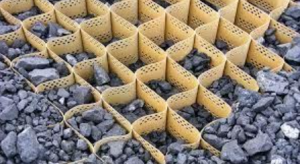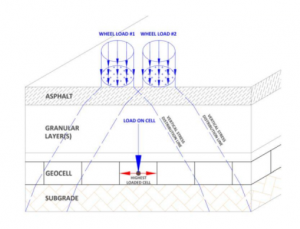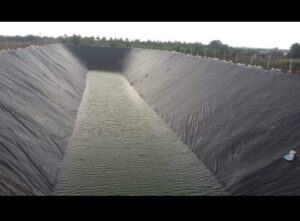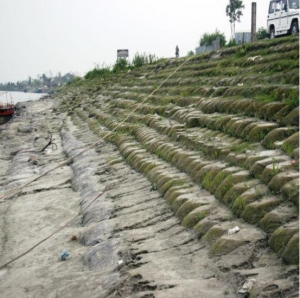How are Geocells Made?

The geocells also called the cell confinement system, or CCS is commonly used for landforms, agriculture, green roofs, roads, trails, golf courses, construction, and road construction.
What is Geocells?
Geocells is three-dimensional, expandable panels made of high-density polyethylene (HDPE), polyester, or other polymer material. During installation, the adhesive sheets are expanded, forming flexible, three-dimensional cell wall walls where filling materials such as sand, soil, rock, etc., are laid and assembled. This creates a free drainage system that holds the filling material and prevents movement by providing a tight-fitting lock. Therefore, geocells improve the structural performance and performance of soil and composite materials.
When pressure is applied to the soil contained within a geocells, as is the case with a load support system, it causes side effects on the cell wall walls. The 3D enclosure minimizes the movement of side-by-side soil particles while direct loading or incomplete content results in greater side compression and resistance to cell interaction with the ground.
Geocells are used in erosion control construction, soil consolidation, channel protection, and structural reinforcement to support load and land conservation. They began to be developed in the late 1970s and early 1980s. Ordinary geocells geosynthetics are made of ultrasonically coated HDPE fibers and expanded on-site to form a honeycomb-shaped structure that is then filled. Geosynthetics is simply a synthetic material used to stabilize space.
The Cellular Confinement System
The key to the increasing power and resilience provided by geocells is in the cellular confinement system (or CCS). When soil or other fillers within the cells are under pressure from above (such as motor weights) the load is distributed over a wide area, as some of the pressure is directed along the walls of the cycle cells. This increases the strength and lifespan of the pavement layer or holding structure.
Through this kind of tensile reinforcement making uses of a three-dimensional confinement zone, infill materials are reserved where they require being and the behavior of the aggregate layer is improved. The confinement system maintains soil compaction, which induces long-term reinforcement. The cells form a kind of stiff ‘mattresses for the layers above. A big benefit of using geocells is that a variety of filler materials can be used, meaning that whatever is to hand and will best suit the individual project can be used to fill in the cells – often enormously reducing the cost of the project, and allowing for ‘greener’ options such as recycled materials to be used. Generally used infill materials, soil or aggregates include sand, local soils, rock, recycled asphalt, gravel, and concrete, depending on the needs of the project.
They are also very helpful in building green walls where the plant layer can grow from the upper layer of the fascia cells. Each cell functions almost as a single plant, helping to retain sufficient moisture and soil nutrients to help promote growth while still allowing adequate water flow. The result is another beautiful and green way to the concrete walls.
What are Geocells made from?
Geocells are usually made of two materials, either HDPE (High-Density Polyethylene) or nano-polymeric alloys (NPA) like Neoloy.
HDPE or ‘soft cells’ are the basic materials used to build geocells systems and provide the flexibility required for less unwanted applications. This will include light-carrying capabilities as well as temporary applications.
In long-term projects, new generation geocells made by NPAs can be used. These solid cells have a 75+ year warranty, create a very strong and durable support layer, and are extremely resistant, making them ideal for heavy-duty activities such as airports, roads, and trains.
How are Geocells Placed?
Once they have been brought to the construction site, the geocells sections are placed in place and tied together on the surface of the subgrade or foundation layer, and then opened. Once the cells have been expanded to cover the required area, they are filled with the required amount and assembled, with an extra layer added.
History and Recent Variation
It was the need for a way to quickly build roads in a soft area for smart use that first prompted the US Army Corps of Engineers to investigate the power of cell phone shutdown systems in 1975. The Mississippi wing tried with many options, including steel sheets and sand grids before coming to a solution similar to the one we use today.
Currently, CCS systems are usually made of fibers (either HDPE or NPA, as mentioned above) that are assembled ultrasonically in standard configuration. Recently, a study led by PRS GeotechTechnologies has shown that strong CCS can be created using NPA, a mixture of polyamide and nano-fibers dispersed in a polyethylene matrix.
Benefits of Using Geocells Technology over Traditional Stabilization Methods:

- Reduced construction and repair costs can be achieved by using geocells in support systems, such as road construction, trains, ports, and airports.
- Increased construction speed while bringing high earthquake resistance to earth retaining walls
- Improved drainage control and station erosion and slope protection
- Decreased carbon footprint
- Ability to use local and recycled materials as fillers
FAQs
Can Geocell be used in coastal areas?
Yes, Geocell can be used in coastal areas to prevent soil erosion and protect against wave action.
Is Geocell suitable for constructing retaining walls?
Yes, Geocell is suitable for constructing retaining walls as it provides stability and reinforcement to the soil mass.
What is the lifespan of Geocell?
Geocell has a lifespan of several decades, depending on the quality of the material, environmental conditions, and proper installation.



